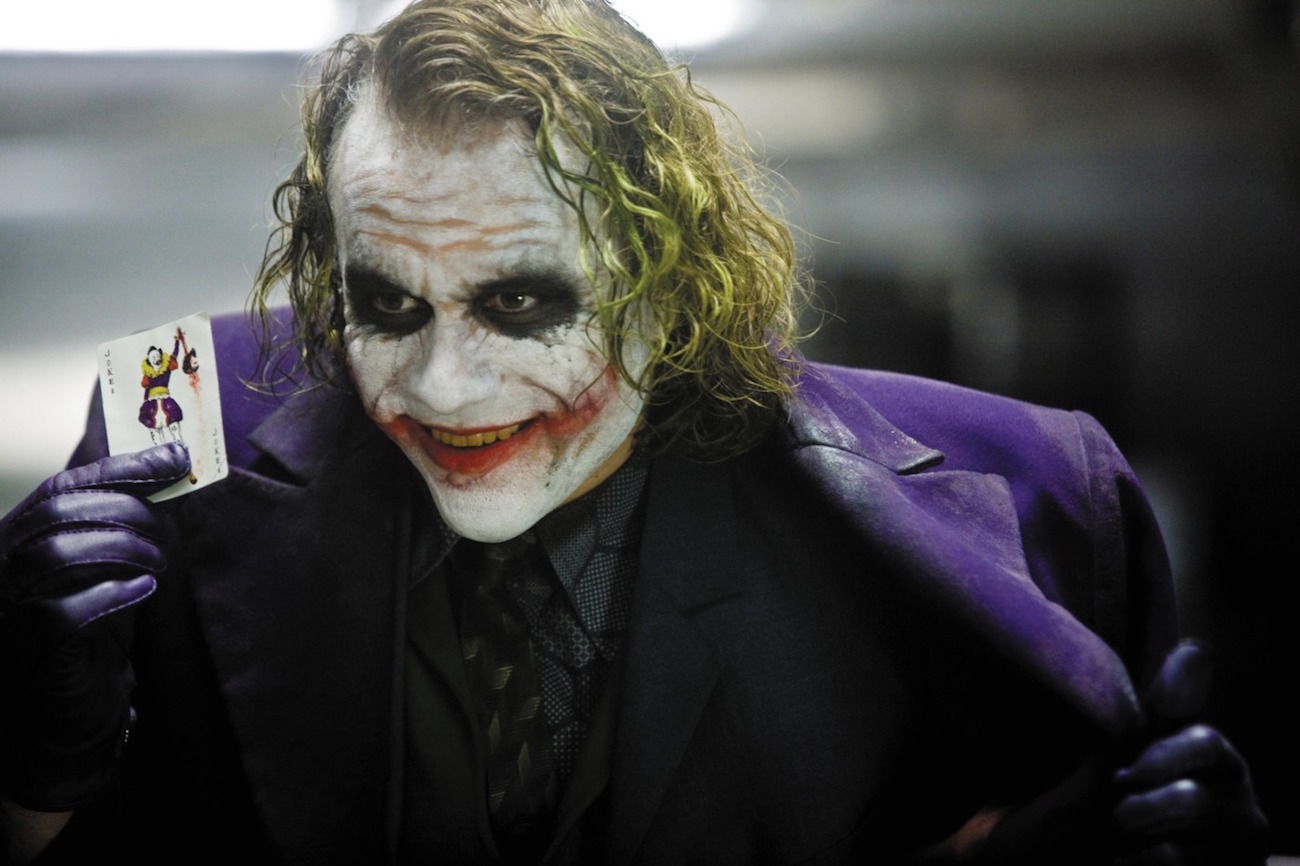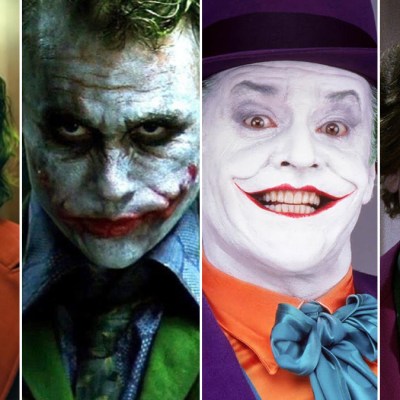It’s one of the great villain introductions in cinema history. Standing with a slight hunch at the center of a massive 70mm image, Heath Ledger’s interpretation of the Joker not so much dominates the frame as he commandeers it. He seduces the IMAX camera, which is still capturing vast amounts of Chicago’s cityscape around him, and draws it closer to his sphere of influence, and by extension us. Before this moment in Christopher Nolan’s The Dark Knight, the director’s Gotham City functioned with clocklike precision. Even its greatest villains were slaves to the need of rationalizing everything in cold, utilitarian logic.
Not the Joker.
Within our first breath next to Ledger’s clown, one senses a malevolent spirit has been summoned, and he’s chosen to manifest out of thin air at this exact moment, on this exact street corner. He’s come to claim Gotham’s collective soul, but he’ll settle for any individual with delusions of virtue who crosses his path—including you.
This is of course just a fleeting moment in The Dark Knight; a brisk tease before Ledger’s shown his makeup-encrusted face or uttered even a word. In fact, Nolan and the actor dole out the character with impressive restraint: first as a masked Mephistopheles who is primarily a sing-song-y voice until he unmasks at the end of a bravura bank robbery. Later he becomes an actual narrative presence when he shows up again more than 20 minutes into the film, demonstrating for Gotham’s criminal underworld how to perform a magic trick.
As an isolated performance, there’s an argument to be made that none has ever been finer in the realm of superhero movies. Sure, there’ve been showy turns before and since in comic book blockbusters; there have even been great interpretations of the Joker before and after Ledger. Yet what the actor was able to do in 2008 transfixed audiences because he, like the character, had the freedom to bend the film to his will—even as Nolan prevented the movie from simply becoming merely a showcase for the performance.
With the grungy strung out hair of an addict who hasn’t showered in three months, greasy self-applied pancake makeup, and a grisly Glasgow smile that’s as unnerving as it is uneven (suggesting perhaps half of it was self-inflicted to make a matching set of scars), Ledger’s anarchist supervillain was a long way from Jack Nicholson’s hammy version of the same character in 1989. For audiences, and even comic book fans baying for something darker than Nicholson, it was abrasive in its time—and electrifying, like a punk rocker leaping into the mosh pit. Indeed, Ledger reportedly based the character’s appearance in part on the Sex Pistols’ Johnny Rotten, and there is more than a hint of Tom Waits’ gravel in Ledger’s cadence whenever the clown growls.
But more than aesthetic culture shock, the enduring horror (and not-so-secret appeal) of Ledger’s Joker lies in the effect he has on the film, both in terms of its narrative storytelling and its enduring pop culture standing. Speaking strictly about this Joker as a character, the villain is off screen for far more of The Dark Knight’s running time than he’s on it. Appearing in only 33 minutes of The Dark Knight’s epic 152-minute running time, the average length of a Hollywood spectacle passes without the Joker on screen. Yet he’s omnipresent in the film, a shadow that hangs over each of Nolan’s three relatively equal protagonists: vigilante Batman (Christian Bale), police lieutenant James Gordon (Gary Oldman), and district attorney Harvey Dent (Aaron Eckhart).
Nolan and his brother and co-screenwriter, Jonathan Nolan, have admitted the setup is somewhat inspired by another quintessential blockbuster, Steven Spielberg’s Jaws. In both films, three disparate, combative male authority figures band together for a mythic battle against a presence so malignant and evil, it transcends being simply a shark or a madman in makeup—or even a comic book supervillain. Like that beast, Joker has no arc, no psychological growth, he’s a force of primal evil unbounded. And as the heroes’ battle against him creeps on, it seems like the sanity of their entire community is being dragged into the abyss.
This framing allows Ledger’s Joker to functionally be a catch-all stand-in for many of the social anxieties that kept American audiences up at night during the Bush years. Some of them still do today. There are of course obvious implications to the Joker being the terrorist, the non-state actor who cannot be negotiated with, and who doesn’t play by preconceived rules or notions of fairness. There is also shading of the lone wolf, the usually male gunman who inexplicably pulls the trigger. Most of all though, the Joker represents the hole in which much of humanity’s irrational predilections toward violence is collectively stored and ignored by our cultural memory… until it can’t be.
As Michael Caine’s Alfred Pennyworth famously reasons, “Some men aren’t looking for anything logical like money. They can’t be bought, bullied, reasoned, or negotiated with. Some men just want to watch the world burn.” That summation of staring into irrational, needless cruelty is what gives The Dark Knight bite. And what a sharp bite it is in moments like when Ledger’s Joker laughs manically at the Batman, our ostensible hero who’s resorted to pummeling (or torturing) the villain in an interrogation room. The clown gloats, “You have nothing to threaten me with, nothing to do with all your strength.”
This is why the Joker is such an effective villain for The Dark Knight’s parable about how best to use moral power in immoral (i.e. irrational) times—and perhaps why the thrill of Ledger’s performance was so strong on first glance that it powered him all the way to a posthumous Oscar in the Best Supporting Actor category seven months after the film’s release.
Still, Ledger’s Joker, more than any other movie villain in recent memory, continues to haunt well after that Oscar night. The mental image of the character slipping his tongue out of the corner of his mouth, like a cobra, and licking his scars—a tic Ledger invented to keep his prosthetics in place while upping the creep factor—has stayed with us like a subconscious boogeyman. Thirteen years on from The Dark Knight’s release, Ledger’s depiction of the Clown Prince of Crime has gone down in the annals of cinema alongside Anthony Hopkins’ Hannibal Lecter in The Silence of the Lambs or, well, that shark in Jaws again. He’s an enigmatic and mysterious persona who is barely seen in his film, yet unmistakably casts a pall of evil over the whole proceeding.
We don’t know why Ledger’s Joker actually became the way he is, or what made him so obsessed with the Batman—to the point where he was inspired to put on “war paint” and declare his love for the Caped Crusader by saying, “You complete me!” The Joker gives multiple versions of his origin story in The Dark Knight, telling one mobster played by Michael Jai White that he’s a victim of an abusive father while later recounting to Rachel Dawes (Maggie Gyllenhaal) that he scarred his own face to cheer up his similarly disfigured wife. Both tales are of course lies, transparent manipulations intended to prey upon perceived vulnerabilities in his victims. This touch was inspired by Alan Moore and Brian Bolland’s The Killing Joke where the comic book Joker provides the reader with a sob story flashback, and then confesses he probably made it up.
“If I’m going to have a past, I prefer it to be multiple choice,” he says on the page.
Read more
The Nolan brothers understand the horror of this, and they keep the Joker a manipulative and inscrutable evil. Beyond obvious sociopathic tendencies, we know nothing about his inner-psychology and barely can ferret out his real motives beyond an odd devotion to maintaining Batman’s attention. He claims to be an agent of chaos who wants to “just do things,” yet his meticulously planned attacks belie this claim. In the end, he sees himself in a battle for “Gotham’s soul.” Like Amity Island’s Great White Leviathan, or the original incomprehensible nature of Thomas Harris’ cannibal serial killer in the earliest books, we never know the truth about why he is, and how he’s able to do what he does.
That mystery makes him live on in our own heads for years after the story ends and the credits roll.
It’s interesting to consider that effect now, after years of pop culture storytelling going in the completely opposite direction, particularly in comic book movies and other fanboy-driven media. Rather than find satisfaction in the inexplicability of evil, or standalone visions, we like to rationalize it and sympathize with it, even while glorifying it. Most of all, however, we insatiably seem to simply want more.
The need for endless content being generated by intellectual property has led to prequels, sequels, and even spinoffs that explore and too often redeem villains. Even the Joker himself is not wholly immune to this.
Since 2008, there have been two big screen versions of the Joker. Jared Leto and Joaquin Phoenix both had the unenviable task of stepping into Ledger’s shadow, with at least one of them being dwarfed by it. Leto’s attempts at “method acting” stunts on the set of Suicide Squad shows what can go wrong when scenery-chewing is mistaken with Strasberg.
Phoenix obviously fared better in his own Joker movie two years ago, making the actor the second performer to win an Oscar for playing the comic book villain. However, his film’s interpretation is diametrically opposed to Ledger’s enigma. Instead Phoenix’s film attempts to rationalize everything about the character, depicting the Joker as a mentally ill sad sack whose motivations are borrowed from other iconic movie screen villains and anti-heroes like the mother-obsessed Norman Bates (Psycho) and ticking time bomb Travis Bickle (Taxi Driver).
It still makes for a fascinating (if unoriginal) portrait, but one divorced from the terror of the unknown. We understand who Phoenix’s Joker is and why he is. Society, man. Phoenix’s Joker even outright states it before murdering not-Johnny Carson (Robert De Niro). “What do you get when you cross a mentally ill loner with a society that abandons him and treats him like trash? I’ll tell you what you get, you get what you fucking deserve!”
Technically, Phoenix’s Joker appears closer to our reality and our daily horrors. With clown makeup inspired by real-life serial killer John Wayne Gacy and preening self-pity parties resembling the manifestos of so many mass murderers, Phoenix’s Arthur Fleck is modeled as much off nightly news nightmares as comic book panels. Writer-director Todd Phillips is inelegantly blatant about it.
Nevertheless, whatever ugly truth there may be in that approach, it’s not as haunting, or exhilarating, to witness as what Ledger did in his own rock star interpretation of evil. Save for a blink-and-you-miss-it insert shot, we never see Ledger with the makeup off. And while he might indulge in mocking “society,” he is a character who says more by basking in the chaos of a city in terror, literally sticking his head out of a stolen police car like a dog with the wind in his hair and our horror on his face. It’s a more enduring image than a didactic conversation about insecurities with a father figure. Thirteen years later, Ledger’s version of the character continues to confound, horrify, and ultimately thrill. He still has the last laugh.


